Instructions to Newby fibre fans on how to wash raw wool the right way …
The right way to wash raw wool is quite simple. Here’s how to do it …
If the wool is very dirty, you can first give it a good shake outside, and let all the dust and debris, as well as those annoying second-cuts fall out. Then spread it open on a table and remove any poop and twigs and anything unwanted, gras or whatever, and pieces of wool that’s all matted and dreadlocked with poop. A good farmer would have removed this from your fleece for starters, it is called ‘skirting’, and this step would then not even be required! Now place it in a tub of room temperature water to rinse out the muck and dust. Swirl around a bit – it’s cold and NO SOAP has been added, so it won’t felt – yet…
Now you fill a bucket/bowl/tub with very hot, but not boiling hot water – maybe 80 degrees Celsius – mainly to soften the lanolin and get it to float. I fill the tub half way with boiling water then top it up with cold water to a point I think feels right. Just too hot to keep your hands in there! Now add some sunlight dish soap or washing soda mix, stir it up, and then drop your wool on top. Your container will depend on the quantity you do at a time – whatever is comfortable to handle, no need to do an entire fleece in one go – I often wash a ‘test’ quantity of around 100g when I get a new fleece.
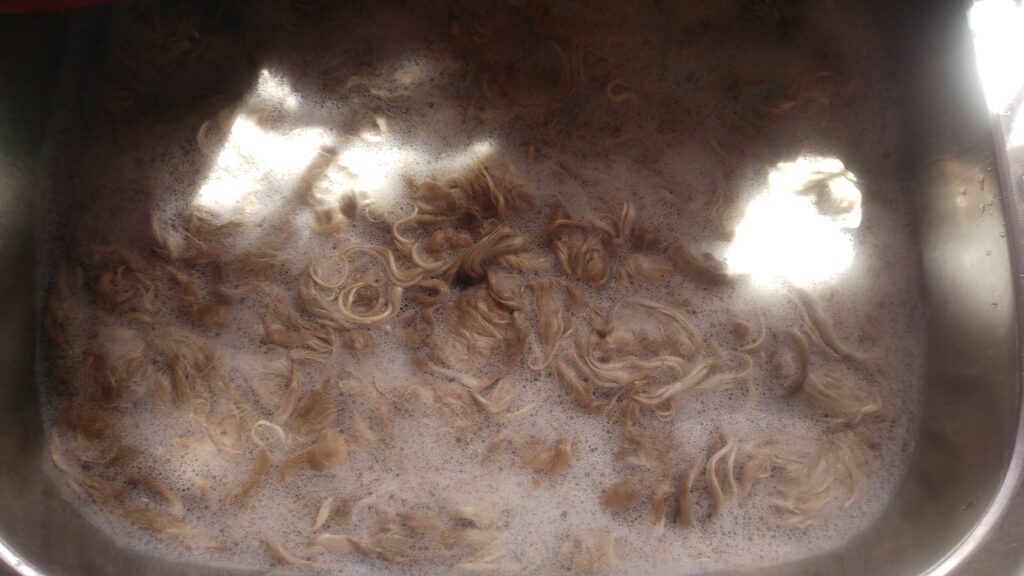
If you have one of the older types of top-loader washing machines, you can even use your washing machine, but be sure you use a setting THAT DOES NOT AGITATE IN DIFFERENT DIRECTIONS!!!!! Never change direction, you’ll end up with a felted blob! Preferably go through the steps manually, one by one and don’t leave your machine to do it’s thing… The spinning – in one direction – is fine…
A good scouring mix is equal parts washing soda and laundry detergent. A teaspoon per 200g wool is actually enough! Same for the dishwashing liquid, you need surprisingly little, and it would be a better idea to repeat the soaping part twice if the fibre is really dirty, you’ll get better results.
I actually have a plastic sieve that fits my bowls, so I drop the wool in the sieve and place both in the water – so it’s easy to remove the wool again without agitating it too much, or get your hands into the muck and chemical-laden water. It does have a very distinct ‘sheepy’ smell, but I rather like it, and the lanolin actually leaves your hands softer…:-) But I can understand that some people will not really take to that – I grew up on a farm, and love sheep, so it reminds me of good times, like running around barefoot as a kid at a time when I had no worries!
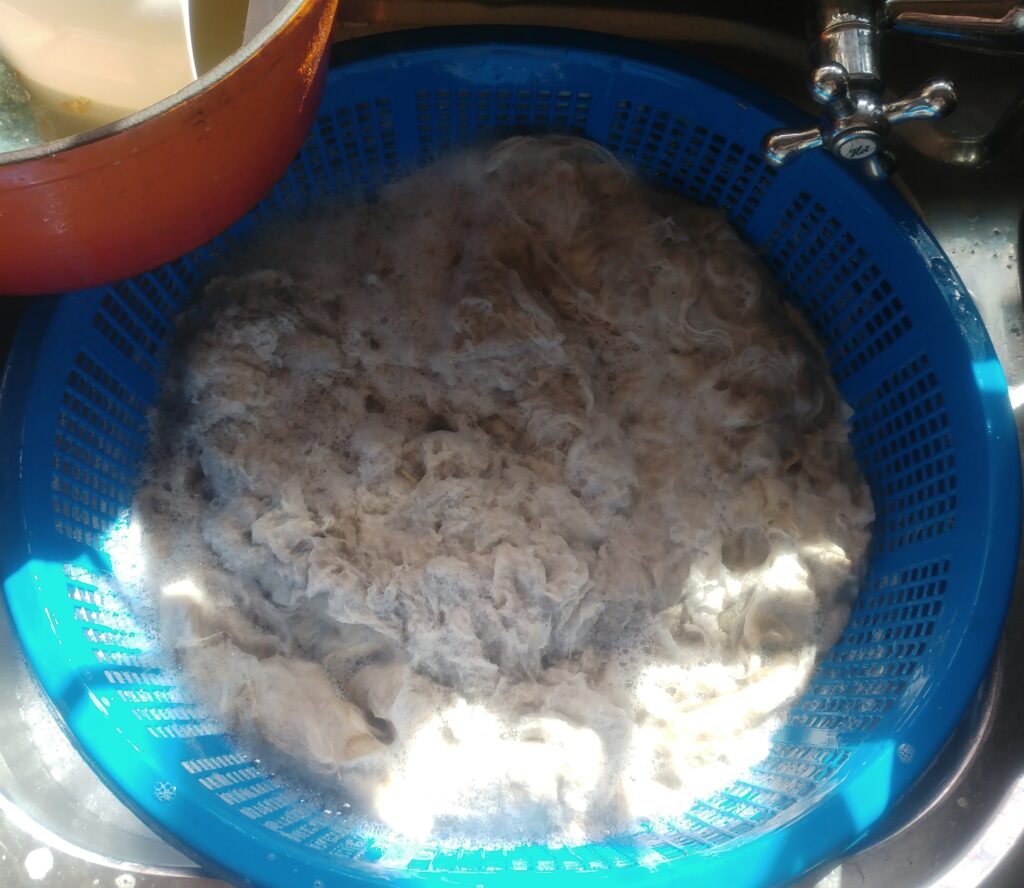
Now, how to wash raw wool the right way… Let it sink at its own leisure, you can give it a bit of a nudge to get it down faster but do NOT start punching and pounding, unless you want a felted blob in the end:-)
We use an extra-long plastic potato masher dedicated for this job – and we wash around 300kg’s of fleece every year…! Alpaca is at least easier as it doesn’t have lanolin and you can get away with washing it in tepid water! But I’m a fibre-holic, so I buy in loads of wool from all over, that has to be cleaned too for blending with my alpaca fibre. Here, Theresa demonstrates how to do it the small but manageable way. The mask was used when she picked and fluffed up those fibres and the dust and debris was floating around everywhere.
When you work with alpaca fibres, this is a must, because they love rolling around in the dust, and since they don’t have any lanolin holding their ‘coats’ together, thus warding off the dust, they actually pick it up! We have to use a leaf blower to blow out most of the dust and debris before shearing, otherwise the cutters are blunt after the first pass!
How to wash raw wool
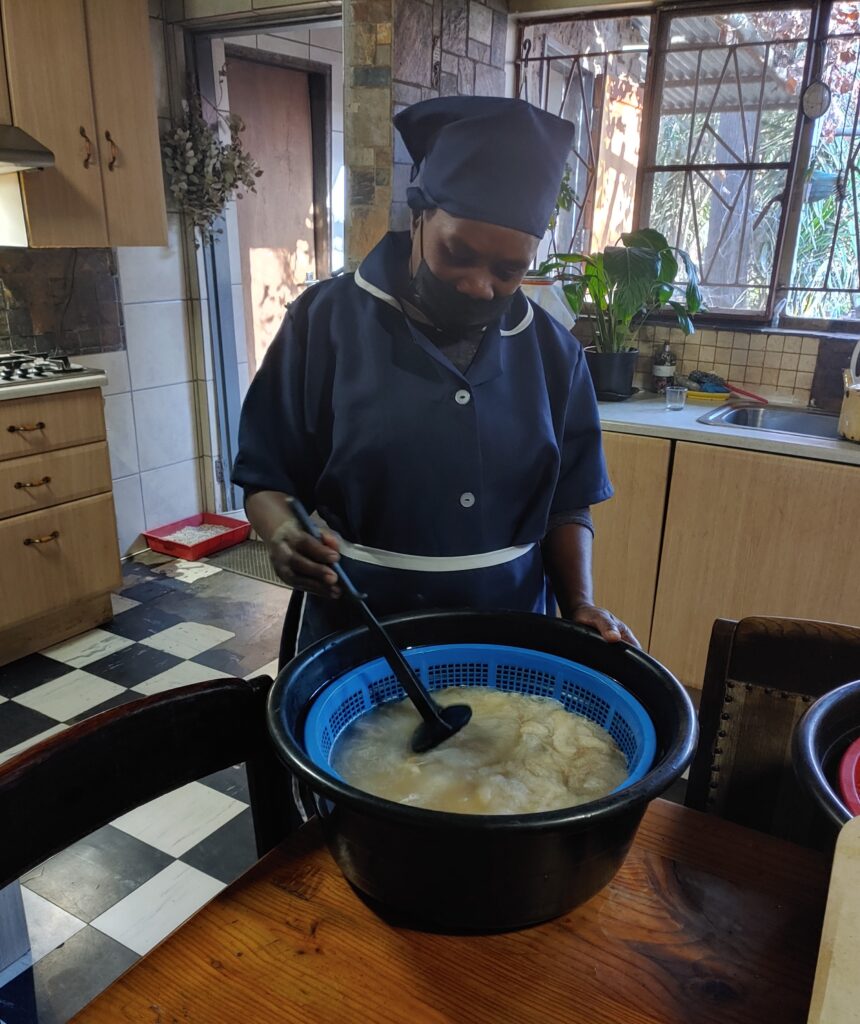
Leave the wool to soak for about 15 mins, to a maximum of 20 minutes. Set a timer, you do NOT want the lanolin to congeal and settle in a layer on top of the wool again, as that would defy the purpose and you’ll have to start over!
Lift out the sieve with wool and let it drain, or pour out the dirty water – this could be quite an issue if it’s a large tub, unless you can just pull the bath plug! Removing the wool by hand and placing it in a different container is another option – I advise some gloves, as the chemicals in the soap may cause sensitivity, and the muck could be stomach-churning to sensitive souls…:-)
Gently squeeze out most of the water, and prepare another tub of water at around the same temperature the wool was in before – it could be slightly hotter but preferably not colder, as the wool will be ‘shocked’ and can start felting – imagine your reaction when getting into a cold swimming pool – you also want to ‘shrink’! But step into a warm bath, you relax…
No need for very hot water any more though!
Now literally ‘rinse and repeat’ these steps until the water is clear.
I find one pre-rinse, one wash, and two rinses to be enough. You actually should leave a bit of lanolin behind, it makes for a much nicer spinning experience, and you will be washing the spun wool to set the twist anyway!
The last rinse you can add some conditioner, fabric softener, or just half a cup of vinegar to get the shafts of the fibre to smooth down again. If you were to look at a strand of fibre under a microscope, it has little scales running down its entire length, like the feathers overlapping on a bird or the scales on a fish. When using a detergent, those little scales lift up, like a bird fluffs up its feathers in cold weather. So, the dirt is easily released. But when you want to complete this process, those scales need a bit of coaxing to return to normal. Usually, the lanolin would smooth this down, but you have just removed it… And in the large mills they actually use corrosive chemicals to dissolve away vegetable matter! Conditioner or fabric softener, or an acid like vinegar will help it ‘fold back it’s feathers’… That’s why vinegar in your final rinsing water when you wash your hair, smooths down your own hair! Try that! And while you’re at it, make sure you add some rosemary twigs to a bottle of apple cider vinegar and set it aside for just this purpose! Hair care!
A word of warning – fabric softeners (unless REALLY Eco blended – and there are many fraudsters in this market too) is NOT really your friend, the chemicals but especially the fake fragrances have a very negative effect on people, they don’t realise it though because they don’t read the small print, or do any research on subjects that really do affect them on a daily basis, and there are many things that affect them! Through my work as a translator, I basically had no choice than to do loads of research on strange subjects…
Thus, I have learned to pin-point the source of my irritations, and as I make all my own soap and have cut out most of the known chemicals from my daily cleaning products and foodstuffs, I immediately feel the pain in my fingers when I wash dishes or wool in certain detergents, but most notably when I rinse my fibre in StaSoft – even Baby Soft nogal!
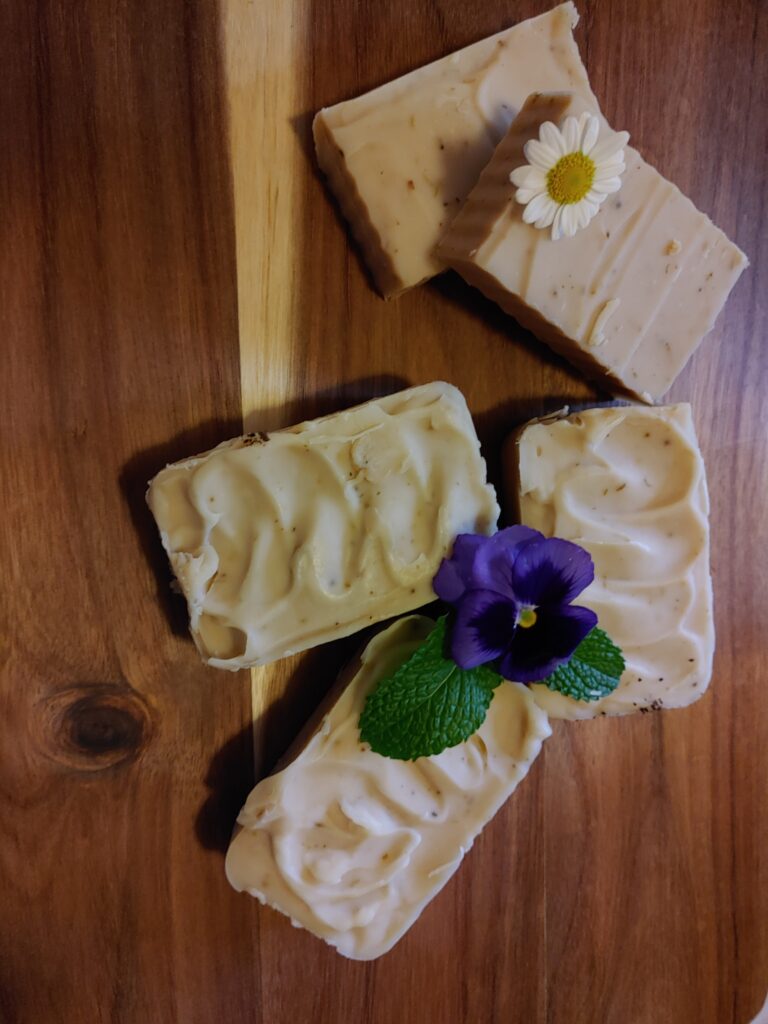
You can wear gloves, yes, but when you pick, card and spin that wool that’s coated with the softener, your hands will know it… And you don’t prep and spin with gloves now do you…
So, I have discovered vinegar works well, and it doesn’t leave any smell. To get that nice smell though, and to keep the moths at bay, I like to spray my dried fibres with a 50/50 blend of water and olive or almond oil, into which I have added a few drops of essential oils. Lavender and Cedar wood are both great! Just shake your bottle well before you spray, and it helps to stop static when you card your wool too!
To dry your washed wool, gently squeeze the water out, I even use a salad spinner to get most water out, and that top loader will come in handy right now – then spread your wool out on a towel on a table to let it dry. You can turn it every so often to speed up the drying!
When I’m in a hurry, I take a towel and roll up my wad of wool, and then do the samba on it:-) After a minute or two of trampling your roll of wool, you can unwrap it and spread it open on another dry towel, and I bet you, you can comb and spin in another hour or two – depending on the size of your batch of course – I’m mostly doing that with small test samples!
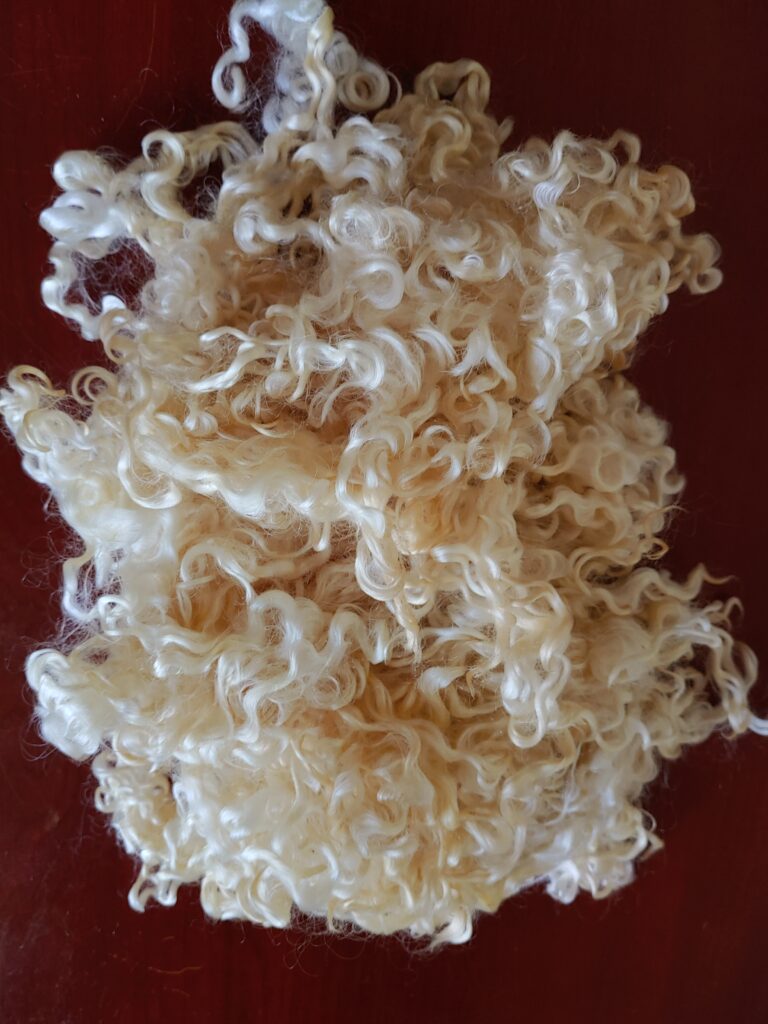
Enjoy your new-found source of fibre, and I hope the instructions on how to wash raw wool was helpful! Please share it with your friends if you know it will be of help to them. If you have some other tips to share, please feel free to leave a comment below!
And please remember, next time you think that pack of fibre prepped for spinning is expensive, it has gone through a lot of steps to get there in that presentation pack for you to spin!
Want to know more about us?
For more information on what else we have in store for you, refer to our pages for more information, https://verlorevallei.com/all-about-alpaca/ or contact us https://verlorevallei.com/contact/!
Follow us on our Facebook page https://www.facebook.com/Fibrewitch to stay up to date with our latest art yarns, fibre specials, bats and rolag packs! Many of which never make it to the website! What’s more, you will get a heads-up when new Majacraft stocks are about to arrive in South Africa, so you can have first dibs! Stock seldom makes it on to the website! We are also working on ‘How-to videos’ on numerous fibre related subjects and life on the farm, which will be posted on Facebook first, unless you follow us on YouTube already, in which case you will be notified. http://www.youtube.com/@VVAFibrecrafts
You can also join our Whatsapp group, where special fibre blend drops or VVA You Tube videos will be announced from time to time – https://chat.whatsapp.com/FWE0y6MTj0uEekmFSm3g6t
We usually also have the following natural alpaca fibre colours in stock, as we have animals in all these colours: Natural White, Light Fawn, Medium Fawn, Dark Fawn, Light Brown, Medium Brown, Dark Brown, Black, light Silver Grey, Medium Silver Grey, Dark Silver Grey, Light Rose Grey, Medium Rose Grey, Dark Rose Grey.
A section for dyed fibres will also be added. You are sure to find something to your liking! We are always open to suggestions, and happy to help with custom orders. We also stock fibre of other sheep breeds that are sourced from the UK from time to time.
